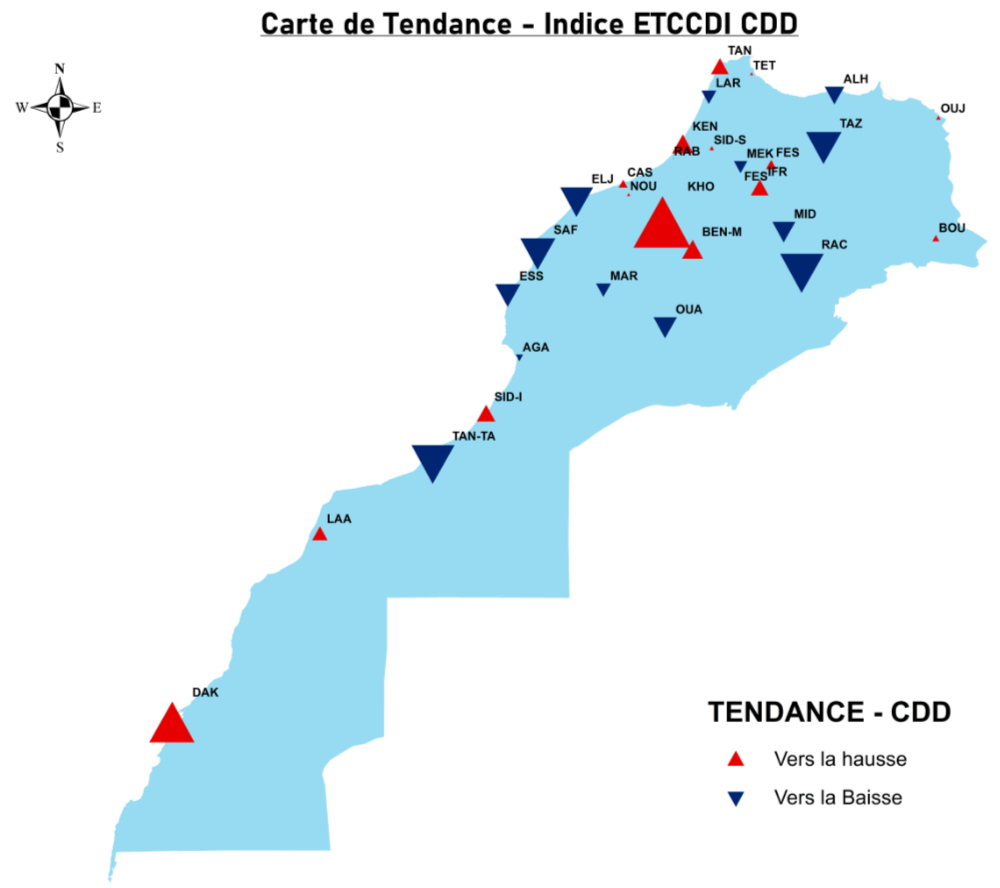Meriem Ouattab PhD thesis
 Regional climate change projections for Morocco: Statistical downscaling method
Regional climate change projections for Morocco: Statistical downscaling method
Started in september 2021
Funding: PHC TOUBKAL program
Supervisors: Albin ULLMAN and Pascal ROUCOU (université de Bourgogne) ; Hicham CHARIFI and Rachid MOUSTABCHIR (IBN-ZOHR, Morocco)
Abstract
As part of my doctoral thesis, I am addressing the following research question: “How can we assess the impact of global climate change on the variability of drought and rainfall extremes in Morocco? This question encompasses two sub-themes: global climate change and the character of the Moroccan climate. The approach to this issue is based on two main phases. The first is a study of the variability of Morocco’s climate over our reference period of 1985-2014, and the second is the statistical downscaling of simulations from global models (CMIP6) using the ESD (Empirical Statistical Downscaling) tool. The aim of the first part is to assess the spatiotemporal variability of precipitation and the trend study of climate extremes in Morocco. To this end, I collected meteorological data from the General Directorate of Meteorology network for 29 synoptic stations meeting quality control and homogeneity criteria throughout the chosen reference period, and hourly ERA5 reanalysis data from the Copernicus CDS covering the entire Moroccan territory for the precipitation parameter. This results in distinct patterns in the spatial distribution of rainfall in Morocco. This analysis of climatic data over several decades highlights a concentration of precipitation in the north-western zones and along the Middle and Grand Atlas ranges, with a remarkable drop throughout our reference period. A trend study was then carried out to analyze climate variability in Morocco, focusing on significant ETCCDI climate indices calculated by an R Climpact2 tool, notably SPI (Standardized Precipitation Index), R95ptot (Total Precipitation from Extremely Wet Days), and CDD (Consecutive dry days). The analysis is based on an exhaustive compilation of historical climate data, spanning several decades and coming from weather stations across the country. The results indicate a variability in precipitation, with differentiated regional trends. In summary, this study provides an in-depth perspective on climate variability in Morocco, highlighting trends in precipitation and key climate indices. These results are crucial for guiding adaptation and mitigation strategies in the face of Morocco’s growing climate change challenges.
Keywords
climate change, regional climate, Morocco, variability, trend, ETCCDI, statistical downscaling
- extrait:
- lien_externe:
- titre:
- Projections régionales du changement climatique pour le Maroc : méthode de réduction d’échelle statistique
- date_de_debut_these:
- septembre 2021
- nom:
- Ouattab
- date_de_debut_these_numerique:
- 202109
- kc_data:
- a:8:{i:0;s:0:"";s:4:"mode";s:0:"";s:3:"css";s:0:"";s:9:"max_width";s:0:"";s:7:"classes";s:0:"";s:9:"thumbnail";s:0:"";s:9:"collapsed";s:0:"";s:9:"optimized";s:0:"";}
- kc_raw_content:
 Regional climate change projections for Morocco: Statistical downscaling method
Regional climate change projections for Morocco: Statistical downscaling methodStarted in september 2021
Funding: PHC TOUBKAL program
Supervisors: Albin ULLMAN and Pascal ROUCOU (université de Bourgogne) ; Hicham CHARIFI and Rachid MOUSTABCHIR (IBN-ZOHR, Morocco)
Abstract
As part of my doctoral thesis, I am addressing the following research question: "How can we assess the impact of global climate change on the variability of drought and rainfall extremes in Morocco? This question encompasses two sub-themes: global climate change and the character of the Moroccan climate. The approach to this issue is based on two main phases. The first is a study of the variability of Morocco's climate over our reference period of 1985-2014, and the second is the statistical downscaling of simulations from global models (CMIP6) using the ESD (Empirical Statistical Downscaling) tool. The aim of the first part is to assess the spatiotemporal variability of precipitation and the trend study of climate extremes in Morocco. To this end, I collected meteorological data from the General Directorate of Meteorology network for 29 synoptic stations meeting quality control and homogeneity criteria throughout the chosen reference period, and hourly ERA5 reanalysis data from the Copernicus CDS covering the entire Moroccan territory for the precipitation parameter. This results in distinct patterns in the spatial distribution of rainfall in Morocco. This analysis of climatic data over several decades highlights a concentration of precipitation in the north-western zones and along the Middle and Grand Atlas ranges, with a remarkable drop throughout our reference period. A trend study was then carried out to analyze climate variability in Morocco, focusing on significant ETCCDI climate indices calculated by an R Climpact2 tool, notably SPI (Standardized Precipitation Index), R95ptot (Total Precipitation from Extremely Wet Days), and CDD (Consecutive dry days). The analysis is based on an exhaustive compilation of historical climate data, spanning several decades and coming from weather stations across the country. The results indicate a variability in precipitation, with differentiated regional trends. In summary, this study provides an in-depth perspective on climate variability in Morocco, highlighting trends in precipitation and key climate indices. These results are crucial for guiding adaptation and mitigation strategies in the face of Morocco's growing climate change challenges.
Keywords
climate change, regional climate, Morocco, variability, trend, ETCCDI, statistical downscaling
